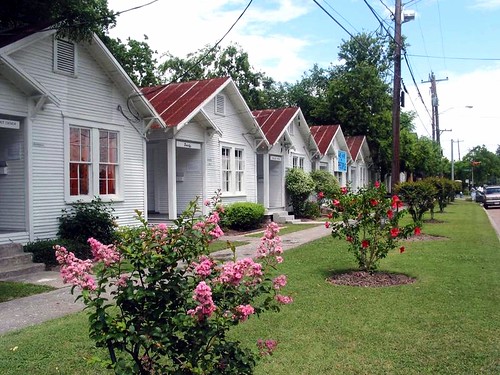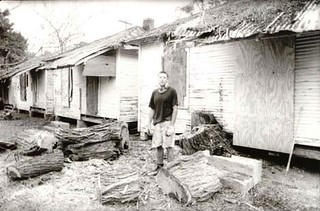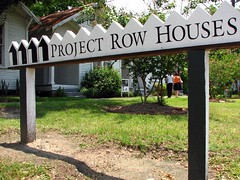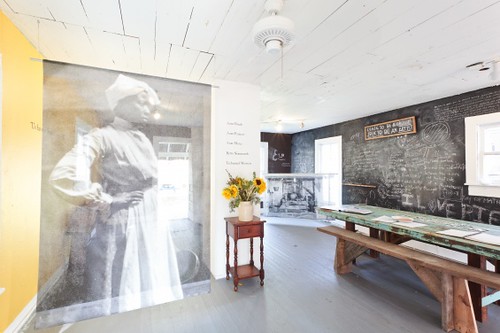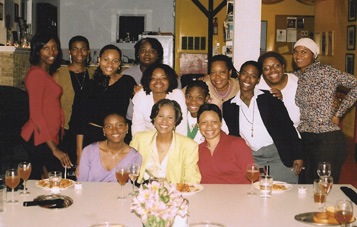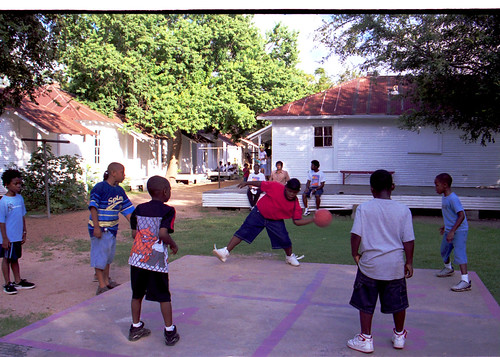Community art or community development? Yes and yes, in Houston's inspiring Project Row Houses

Posted September 20, 2012 at 1:35PM
Anyone familiar with my writing and work knows I am all in on revitalization, when it’s done sensitively and with inclusion. Nothing has been worse for our environment in the last several decades than the decay and disinvestment of our inner cities and accompanying suburban sprawl. Strengthening the places we have before building new ones is critical to environmental recovery, and in my opinion doing so is inherently green whether or not we are able to add explicitly green features.
As I noted earlier this week in reviewing Chuck Marohn’s new book on Strong Towns, strengthening what we have is critical to economic recovery, too.
While I have an increasing number of favorite examples of distressed neighborhoods being restored and strengthened - and that in itself is great news - none is more imaginative and inspiring than Houston’s amazing Project Row Houses. I first discovered PRH four years ago, though the project was established back in 1993, on the site of 22 abandoned shotgun houses (circa 1930) in Houston's Third Ward. (Shotgun houses are narrow one-story dwellings without halls.) Artist and PRH founder Rick Lowe began with the rehabilitation of ten of the twenty-two houses so that they could become home to rotating installations and exhibits of African-American community art, photography, and literary projects.
Adjacent to the houses dedicated to art are seven more that were then rehabilitated to become the home of The Young Mothers Program, which provides transitional housing and structured services for young mothers and their children. And, in 2003, the Row House Community Development Corporation was formed as a sister organization to Project Row Houses, in order to develop additional, architecturally compatible housing for low-to-moderate income residents, along with public spaces and facilities to preserve and protect the historic character of the Third Ward.
Today, according to the Project Row Houses website, the campus has grown from the original block and a half to six blocks, and from 22 houses to 40 properties; these now include twelve artist exhibition and/or residency spaces, the seven houses for young mothers, office spaces, a community gallery, a park, and additional low-income residential and commercial spaces. From the site:
“PRH is founded on the principle that art - and the community it creates - can be the foundation for revitalizing depressed inner-city neighborhoods. This principle was is in part based on the philosophy of German artist Joseph Beuys (1921 – 1986) who coined the phrase “social sculpture,” which transformed the idea of sculpture as an art form into a social activity. Thus, the mission of Project Row Houses is to create community through the celebration of art, African American history and culture.
“PRH has established programs that encompass arts and culture, neighborhood revitalization, low-income housing, education, historic preservation, and community service.”
A key inspiration for Lowe was the work of the influential artist, muralist and educator Dr. John Biggers (1924 – 2001) and his principles concerning the establishment of effective communities through art, architecture, community support and creativity as “exemplified in African traditions wherein art is interwoven into the very fabric of life through rituals and ceremony activities.”
The PRH website lists a wide variety of projects and programs related to its three core activities of public art, arts education, and the Young Mothers Program. All are fascinating and one, called the GreenHouse Collective, is explicitly environmental. It grew out of a 2009 art installation featuring an indoor vegetable garden under grow lights, and spawned a community garden including water catchment, irrigation systems, fruit trees, edible landscaping, a greenhouse, and an aquaponics system. The Collective provides gardening workshops to community members, hands-on classes for kids enrolled in PRH’s summer and after-school programs, green art projects for kids and, of course, food and flowers for the neighborhood.
There’s much more on the websites of PRH and the Row House CDC. My sense is that, although art and development are the lenses through which the project has evolved, its most important contributions to its community may be pride and empowerment. Here’s Rick Lowe, as quoted in an article by Gregory Sholette on Huffington Post:
“We started to shift the dynamics of the economic structures around the community. There are a lot of people making a lot of money building houses, and they're gonna be making a lot of money building houses right around us if we don't figure out some way of dealing with that. So we decided to reap the benefits of developing and after a couple of years of studying and planning, we put together a new community development corporation and started buying land and building houses.
“At this point, we've built thirty-eight units of newly constructed houses with an additional twenty-eight that we're planning. It's giving us the opportunity to do some things that can control our economic destiny even though, because we're pushing to keep the rents low, it's not like a huge moneymaking thing for us. But it's giving us... control over property, land in that neighborhood, and determining how that place grows economically in the future. And it breaks up that concentration of poverty. That is important.”
Filmmaker Andrew Garrison produced an excellent documentary about Project Row Houses in 2007. It's called Third Ward TX. Here’s a short clip that will make all the descriptions come alive:
Related posts:
- Terrific short video on arts-driven placemaking (June 15, 2012)
- National arts partnership steps up big for community revitalization (June 12, 2012)
- Strengthening community through interactive street art (NOLA resilience part 2) (May 12, 2011)
- Positive energy + bikes + art = vibrant community in E-Ho, LA (March 11, 2009)
- Ambitious, revitalizing arts district goes green in Syracuse (February 9, 2011)
- Arts-driven revitalization in Kentucky - yes, Kentucky (December 17, 2010)
- Amazing community art & development projects (part 2 of 2: LA's Watts House Project) (November 10, 2008)
Move your cursor over the images for credit information.
Please also visit NRDC’s sustainable communities video channels.
